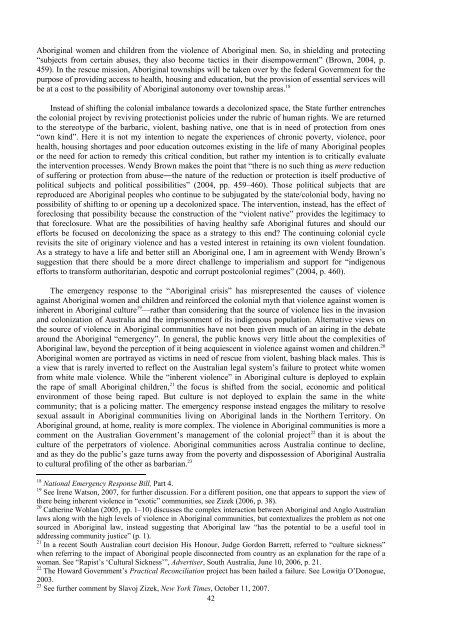traditional knowledge conference 2008 te tatau pounamu
traditional knowledge conference 2008 te tatau pounamu
traditional knowledge conference 2008 te tatau pounamu
You also want an ePaper? Increase the reach of your titles
YUMPU automatically turns print PDFs into web optimized ePapers that Google loves.
Aboriginal women and children from the violence of Aboriginal men. So, in shielding and pro<strong>te</strong>cting“subjects from certain abuses, they also become tactics in their disempowerment” (Brown, 2004, p.459). In the rescue mission, Aboriginal townships will be taken over by the federal Government for thepurpose of providing access to health, housing and education, but the provision of essential services willbe at a cost to the possibility of Aboriginal autonomy over township areas. 18Ins<strong>te</strong>ad of shifting the colonial imbalance towards a decolonized space, the Sta<strong>te</strong> further entrenchesthe colonial project by reviving pro<strong>te</strong>ctionist policies under the rubric of human rights. We are returnedto the s<strong>te</strong>reotype of the barbaric, violent, bashing native, one that is in need of pro<strong>te</strong>ction from ones“own kind”. Here it is not my in<strong>te</strong>ntion to nega<strong>te</strong> the experiences of chronic poverty, violence, poorhealth, housing shortages and poor education outcomes existing in the life of many Aboriginal peoplesor the need for action to remedy this critical condition, but rather my in<strong>te</strong>ntion is to critically evalua<strong>te</strong>the in<strong>te</strong>rvention processes. Wendy Brown makes the point that “there is no such thing as mere reductionof suffering or pro<strong>te</strong>ction from abuse―the nature of the reduction or pro<strong>te</strong>ction is itself productive ofpolitical subjects and political possibilities” (2004, pp. 459–460). Those political subjects that arereproduced are Aboriginal peoples who continue to be subjuga<strong>te</strong>d by the sta<strong>te</strong>/colonial body, having nopossibility of shifting to or opening up a decolonized space. The in<strong>te</strong>rvention, ins<strong>te</strong>ad, has the effect offoreclosing that possibility because the construction of the “violent native” provides the legitimacy tothat foreclosure. What are the possibilities of having healthy safe Aboriginal futures and should ourefforts be focused on decolonizing the space as a stra<strong>te</strong>gy to this end? The continuing colonial cyclerevisits the si<strong>te</strong> of originary violence and has a ves<strong>te</strong>d in<strong>te</strong>rest in retaining its own violent foundation.As a stra<strong>te</strong>gy to have a life and bet<strong>te</strong>r still an Aboriginal one, I am in agreement with Wendy Brown’ssuggestion that there should be a more direct challenge to imperialism and support for “indigenousefforts to transform authoritarian, despotic and corrupt postcolonial regimes” (2004, p. 460).The emergency response to the “Aboriginal crisis” has misrepresen<strong>te</strong>d the causes of violenceagainst Aboriginal women and children and reinforced the colonial myth that violence against women isinherent in Aboriginal culture 19 —rather than considering that the source of violence lies in the invasionand colonization of Australia and the imprisonment of its indigenous population. Al<strong>te</strong>rnative views onthe source of violence in Aboriginal communities have not been given much of an airing in the deba<strong>te</strong>around the Aboriginal “emergency”. In general, the public knows very little about the complexities ofAboriginal law, beyond the perception of it being acquiescent in violence against women and children. 20Aboriginal women are portrayed as victims in need of rescue from violent, bashing black males. This isa view that is rarely inver<strong>te</strong>d to reflect on the Australian legal sys<strong>te</strong>m’s failure to pro<strong>te</strong>ct whi<strong>te</strong> womenfrom whi<strong>te</strong> male violence. While the “inherent violence” in Aboriginal culture is deployed to explainthe rape of small Aboriginal children, 21 the focus is shif<strong>te</strong>d from the social, economic and politicalenvironment of those being raped. But culture is not deployed to explain the same in the whi<strong>te</strong>community; that is a policing mat<strong>te</strong>r. The emergency response ins<strong>te</strong>ad engages the military to resolvesexual assault in Aboriginal communities living on Aboriginal lands in the Northern Territory. OnAboriginal ground, at home, reality is more complex. The violence in Aboriginal communities is more acomment on the Australian Government’s management of the colonial project 22 than it is about theculture of the perpetrators of violence. Aboriginal communities across Australia continue to decline,and as they do the public’s gaze turns away from the poverty and dispossession of Aboriginal Australiato cultural profiling of the other as barbarian. 2318 National Emergency Response Bill, Part 4.19 See Irene Watson, 2007, for further discussion. For a different position, one that appears to support the view ofthere being inherent violence in “exotic” communities, see Zizek (2006, p. 38).20 Catherine Wohlan (2005, pp. 1–10) discusses the complex in<strong>te</strong>raction between Aboriginal and Anglo Australianlaws along with the high levels of violence in Aboriginal communities, but con<strong>te</strong>xtualizes the problem as not onesourced in Aboriginal law, ins<strong>te</strong>ad suggesting that Aboriginal law “has the po<strong>te</strong>ntial to be a useful tool inaddressing community justice” (p. 1).21 In a recent South Australian court decision His Honour, Judge Gordon Barrett, referred to “culture sickness”when referring to the impact of Aboriginal people disconnec<strong>te</strong>d from country as an explanation for the rape of awoman. See “Rapist’s ‘Cultural Sickness’”, Advertiser, South Australia, June 10, 2006, p. 21.22 The Howard Government’s Practical Reconciliation project has been hailed a failure. See Lowitja O’Donogue,2003.23 See further comment by Slavoj Zizek, New York Times, October 11, 2007.42
















